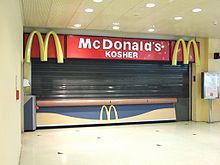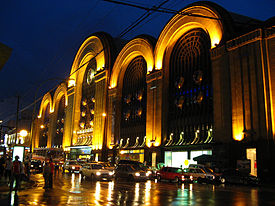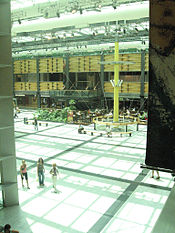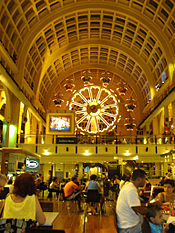- Abasto de Buenos Aires
-
The Abasto de Buenos Aires was the central wholesale fruit and vegetable market in Buenos Aires, Argentina, from 1893 to 1984. Since 1999, it has served as a shopping mall, Abasto Shopping. It is also famous for being in the area where the tango singer Carlos Gardel, known as El Morocho del Abasto ("the dark-haired guy from Abasto"), lived for most of his life. Today, the surrounding area, though part of the Balvanera neighbourhood, is sometimes referred to as Abasto.
The Abasto Shopping centre is served by the adjoining underground station Carlos Gardel of line B metro (subte).
History
By the end of the 19th century, the city of Buenos Aires was expanding rapidly due to the influx of migrants from various European countries. Because of the demographic change, and the demolition of the Mercado Modelo market near the Plaza Lorea, the Devoto brothers on August 16, 1888, proposed the construction of a supply market on the land they acquired in 1875 in the Balvanera neighbourhood. The land was near the Sarmiento railway and halfway between La Boca and Olivos, two zones of fruit and vegetable production.
The town hall accepted the proposal on November 29 of that year, and passed it on to the Deliberating Council, who sanctioned it on January 8, 1889, in an ordinance approving the construction of the Mercado Central de Abasto ("Central Supply Market") on the 25,000 m² plot of land between Corrientes Avenue, Lavalle, Anchorena and Laprida streets. The municipality allowed the Abasto market to become wholesalers of fruit, vegetables and other foodstuffs, but forbade the sale of meat.
The old marketeers of the Mercado Modelo associated and founded in 1889 the Sociedad Anónima Mercado de Abasto Proveedor ("Market Supply Provider Anonymous Society"), which bought from the Devoto brothers the land and the concession to build the Mercado de Abasto. The construction of the building started shortly after the sale had been approved by mayor Francisco Seeber, and the first section was inaugurated on April 1 of 1893, with a covered area of 1,300 m².
Ten years later a refrigerated storage and an ice factory were opened, to satisfy the city's hygiene standards of the times. Since the population, and with it consumer demand, was steadily growing, it was necessary to construct a parking area for horses and vehicles. In 1928 an annex for retail sale was built between Guardia Vieja, Lavalle, Gallo and Bustamante streets.
 Kosher McDonald's Restaurant at the Abasto Shopping centre. The photo was taken on a Saturday (Shabbat), and it was therefore closed.
Kosher McDonald's Restaurant at the Abasto Shopping centre. The photo was taken on a Saturday (Shabbat), and it was therefore closed.
Consumer demand again led to the overcrowding of the markets of the city, so architects José Luis Delpini, Viktor Sulčič and Raúl Bes designed a new market in the location of the Abasto market. Work started on December 28 of 1931 with the foundations and finished in 1934. The new Mercado de Abastos had an area of 44,000 m2 (473,612 sq ft), railway access and underground parking. In 1939, the sale of meat and fish was allowed.
On October 14, 1984 the central market was moved to the present Mercado Central, location, outside the city of Buenos Aires, and the Abasto of Buenos Aires was closed and left abandoned. It was not until the mid-1990s that a project was proposed for turning the Abasto into a shopping mall. In 1996 the building was sold to IRSA, which restored the facade and remodeled and restored its interior. Abasto Shopping Centre was opened in 1999, and houses brands like Lacoste, Adidas, Nike, Yves Saint Laurent, Christian Dior, New Man, among others.
External links
Coordinates: 34°36′13″S 58°24′39″W / 34.60361°S 58.41083°W
Landmarks of Buenos Aires Note: "Buenos Aires" denotes the city of Buenos Aires proper, not the entire Greater Buenos Aires metropolitan area.Public
& historic buildings
and structuresArgentine Congress · Torre Monumental · Cabildo · Café Tortoni · Casa Rosada · Central Post Office · City Hall · City Legislature · Customs House · Duhau Palace · Estrugamou Building · Floralis Genérica · Galerías Pacífico · Hotel de Inmigrantes · Kavanagh building · Libertador Building · Metropolitan Cathedral · Monument to Giuseppe Garibaldi · Obelisk of Buenos Aires · Palacio Barolo · May Pyramid · Pizzurno Palace · Plaza Hotel · Recoleta Cemetery · San Martín Palace · Sarmiento Frigate · Uruguay Corvette · The Water Company Palace · Women's BridgePrecincts
& neighbourhoodsAlmagro · Belgrano · Buenos Aires CBD · Caballito · City Centre · Colegiales · Montserrat · Núñez · Palermo · Puerto Madero · Recoleta · Retiro · San TelmoNature and parks Avellaneda Park · Botanical gardens · Buenos Aires Ecological Reserve · Chacabuco Park · Congressional Plaza · Japanese Gardens · Lezama Park · Palermo gardens · Plaza de la República · Plaza de Mayo · Plaza San Martín · Parque Centenario · Buenos Aires ZooCultural
InstitutionsEl Ateneo Bookstore · Argentine Automobile Club · Bernardino Rivadavia Natural Sciences Museum · Buenos Aires Museum of Modern Art · Café Tortoni · Fortabat Art Collection · House of Culture · Illuminated Block · Isaac Fernández Blanco Museum · King Fahd Cultural Center · Latin American Art Museum · Museum of Foreign Debt · National Library · National Museum of Decorative Arts · National Museum of Fine Arts · National Museum of History · Opera House · Paz Palace · Planetarium · Recoleta Cultural Center · San Martín Cultural Center · San Martín National Institute · Sarmiento Museum · Eduardo Sívori MuseumSport Bombonera Stadium · River Plate Stadium · Ducó Stadium · Maradona Stadium · Vélez Sársfield Stadium · Argentine Hippodrome of Palermo · Lawn Tennis Club · Polo Stadium · Race Circuit · Arena Obras Sanitarias · CeNARD · Estadio Ricardo EtcheverryTransportation Shopping
& entertainmentAbasto Mall · Avenida Theatre · Cervantes Theatre · Fishermen's Pier · Galerías Pacífico · Gran Rex Theatre · Luna Park Arena · Paseo La Plaza · Patio Bullrich · Opera Theatre · Parque de la Ciudad · La Trastienda ClubStreets
& avenues9 de Julio Avenue · Avenida Alvear · Avenida de Mayo · Avenida del Libertador · Callao Avenue · Caminito · Córdoba Avenue · Coronel Díaz Street · Corrientes Avenue · Figueroa Alcorta Avenue · Florida Street · General Paz Avenue · Leandro Alem Avenue · President Roque Sáenz Peña Avenue · Rivadavia Avenue · Santa Fe Avenue · Scalabrini Ortiz AvenueCategories:- Shopping malls in Argentina
- Buildings and structures in Buenos Aires
- Visitor attractions in Buenos Aires
- 1934 architecture
Wikimedia Foundation. 2010.



